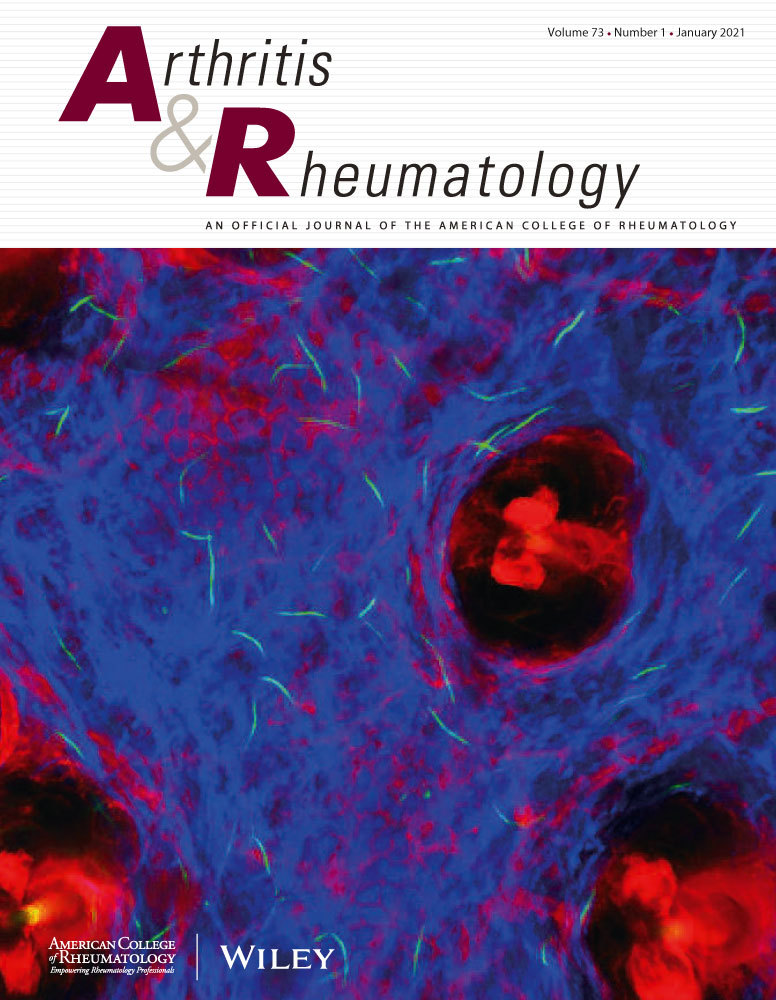Longitudinal Autoantibody and Proteomic Profiles Uncover Biomarkers and Mechanisms of Disease Progression in Systemic Sclerosis
IF 10.9
1区 医学
Q1 RHEUMATOLOGY
引用次数: 0
Abstract
ObjectiveTo evaluate dynamic changes in autoantibody and proteomic profiles in treatment‐naïve systemic sclerosis (SSc) patients and identify biomarkers and mechanisms associated with disease progression.MethodsSerum samples from 30 baseline and 49 follow‐up SSc patients, along with 38 controls, were analyzed. Autoantibody profiles were assessed using an autoantigen microarray targeting 120 autoantibodies, while proteomic analysis was conducted via liquid chromatography–mass spectrometry in data‐independent acquisition mode. Cox proportional hazards models were used to assess associations with disease progression, and Spearman's correlation was applied to analyze antibody‐protein interactions.ResultsBaseline autoantibody profiling identified two patient subgroups: high‐expression (SSc_high) and low‐expression (SSc_low), though their clinical characteristics were similar. Longitudinal analysis revealed that 88.9% of patients with rising autoantibody titers experienced disease progression, while 60% of those with decreasing titers showed clinical improvement. Notably, increased CENP‐B titers (HR = 5.036) were strongly linked to disease progression. Proteomic analysis identified 112 proteins involved in tissue repair and immune modulation in patients with declining titers and clinical improvement, whereas 46 proteins linked to lipid metabolism and oxidative stress were enriched in those with rising titers and disease progression. SERPINA10 emerged as the strongest risk factor for progression, while ENTPD5 was most protective. Antibody‐protein correlations highlighted key molecular interactions, including SERPINE1 and muscarinic receptor antibodies, were identified.ConclusionDynamic changes in autoantibody titers, rather than baseline levels, were more strongly associated with SSc trajectory. Proteomic signatures suggest lipid metabolism and oxidative stress as potential drivers, highlighting novel biomarkers and therapeutic targets for personalized SSc management.纵向自身抗体和蛋白质组学分析揭示了系统性硬化症的生物标志物和疾病进展机制
目的评估治疗naïve系统性硬化症(SSc)患者自身抗体和蛋白质组学特征的动态变化,并确定与疾病进展相关的生物标志物和机制。方法分析30例基线和49例随访SSc患者的血清样本,以及38例对照。使用针对120种自身抗体的自身抗原微阵列评估自身抗体谱,而通过数据独立获取模式的液相色谱-质谱法进行蛋白质组学分析。Cox比例风险模型用于评估与疾病进展的相关性,Spearman相关用于分析抗体-蛋白相互作用。结果基线自身抗体谱分析确定了两个患者亚组:高表达(SSc_high)和低表达(SSc_low),尽管他们的临床特征相似。纵向分析显示,88.9%自身抗体滴度升高的患者出现疾病进展,而60%滴度降低的患者表现出临床改善。值得注意的是,增加的CENP‐B滴度(HR = 5.036)与疾病进展密切相关。蛋白质组学分析发现,在滴度下降和临床改善的患者中,有112种蛋白质参与组织修复和免疫调节,而在滴度上升和疾病进展的患者中,有46种蛋白质与脂质代谢和氧化应激相关。SERPINA10是进展的最强危险因素,而ENTPD5是最具保护性的。抗体-蛋白相关性突出了关键分子相互作用,包括SERPINE1和毒蕈碱受体抗体。结论自身抗体滴度的动态变化与SSc发展轨迹的相关性高于基线水平。蛋白质组学特征表明脂质代谢和氧化应激是潜在的驱动因素,突出了个性化SSc管理的新生物标志物和治疗靶点。
本文章由计算机程序翻译,如有差异,请以英文原文为准。
求助全文
约1分钟内获得全文
求助全文
来源期刊

Arthritis & Rheumatology
RHEUMATOLOGY-
CiteScore
20.90
自引率
3.00%
发文量
371
期刊介绍:
Arthritis & Rheumatology is the official journal of the American College of Rheumatology and focuses on the natural history, pathophysiology, treatment, and outcome of rheumatic diseases. It is a peer-reviewed publication that aims to provide the highest quality basic and clinical research in this field. The journal covers a wide range of investigative areas and also includes review articles, editorials, and educational material for researchers and clinicians. Being recognized as a leading research journal in rheumatology, Arthritis & Rheumatology serves the global community of rheumatology investigators and clinicians.
 求助内容:
求助内容: 应助结果提醒方式:
应助结果提醒方式:


